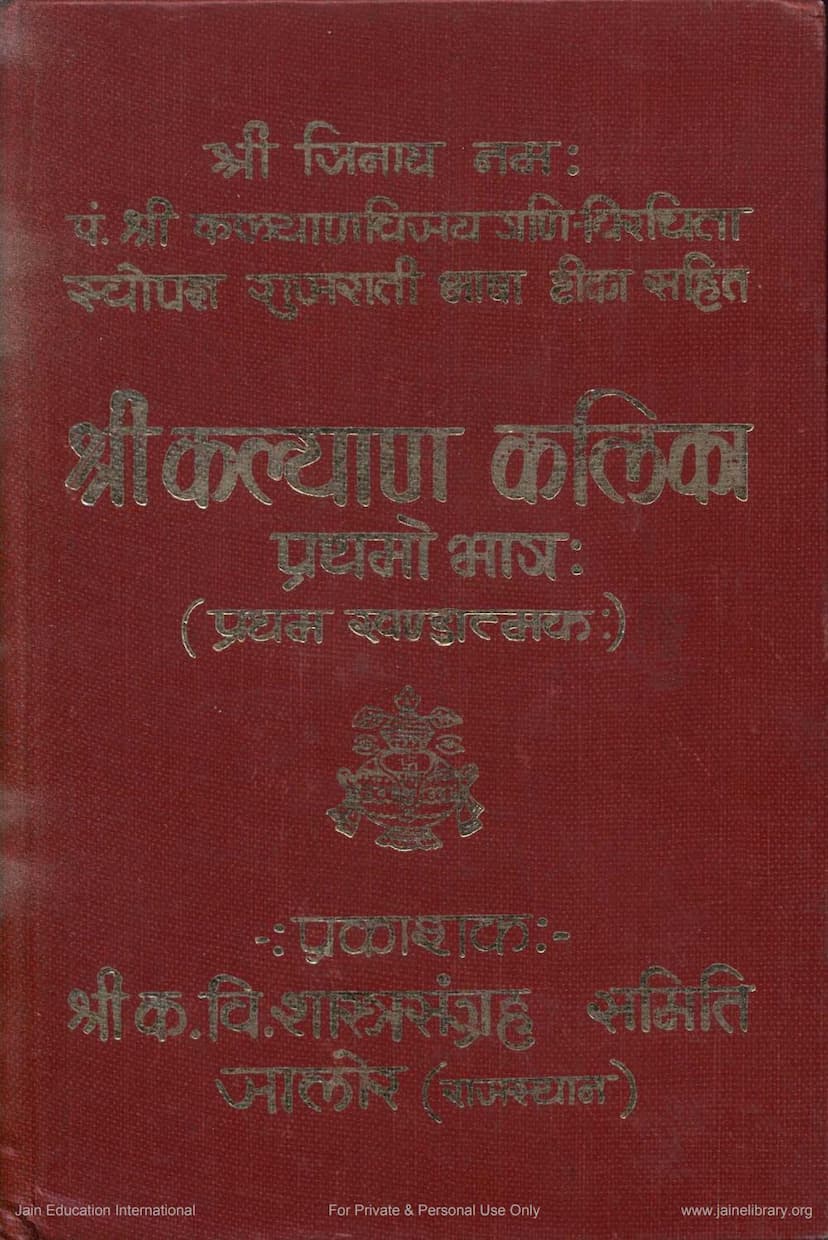Kalyan Kalika Part 1
Added to library: September 2, 2025

Summary
This document is the first part of the Jain text "Kalyan Kalika" authored by Kalyanvijay Gani. It is published by Shri K. V. Shastra Sangrah Samiti, Jalor. The catalog link provided is https://jainqq.org/explore/001722/1.
This volume is the first part of the "Kalyan Kalika" and is referred to as the "Pratham Khandatmak". It was published in Sanskrit-Prakrit language with a Gujarati commentary. The second edition was printed in 1000 copies in Samvat 2513 V.S. (2043 V.S.) which corresponds to 1987 CE.
The publication expresses gratitude towards Panyas Panyas Kalyanvijayji Ganivar's disciple, Munishri Muktivijayji Maharaj Saheb, for his dedication in completing the unfinished works of his Guru. It highlights the magnificent Nadeshwar Tirtha and the Kirtistambh in Jalor, which spread the Guru's fame. The text acknowledges the annual fair held at Nadeshwar Tirtha on Maha Sud 6, where devotees from Rajasthan participate. It also mentions the grand temples of Nemnath Bhagwan and Simdhar Swami, along with the Mahavir Swami temple and the Kirtistambh, all contributing to Jalor becoming a significant pilgrimage site.
The "Smarananjali" (Tribute) section offers a detailed tribute to the author, Pandit Kalyanvijayji Ganivar. He is described as a profound scholar of Jain scriptures, grammar, logic, history, rituals, and astrology. He is recognized for his unique research in Jain history, contributing significant findings that were valued by scholars across India, as evidenced by his work "Veernirvan Samvat and Mahavir Kalganana". He authored approximately thirty original and thought-provoking books. The text provides biographical details: born in Samvat 1944 in Las village, Rajasthan; initiated at the age of 19 in Jalor in Samvat 1963; received Gani and Panyas titles in Ahmedabad in Samvat 1994; and passed away in Jalor in Samvat 2031. His lifespan was 87 years, with 68 years of renunciation.
The text further elaborates on his expertise, drawing parallels with the renowned scholar Punyavijayji Maharaj Saheb and highlighting his inspiration for him in the field of ancient text research. Kalyanvijayji Ganivar's deep knowledge of Agama texts is evidenced by his work on Nishiath, Mahanishiath, and other scriptures, revealing insights unknown even to learned monks for centuries, as presented in his works like "Pattavali" and "Nibandh Nischay". "Kalyan Kalika" parts 1 and 2 are noted for their comprehensive treatment of rituals, astrology, and ancient architecture. His other notable works like "Shraman Bhagwan Mahavir" and "Veernirvan Samvat and Jain Kal Ganana" are praised for their meticulous research, which commanded respect from historians nationwide. He possessed a remarkable ability to investigate even the smallest details, such as inscriptions on ancient pillars or texts found in old manuscripts, extracting historical and philosophical truths from seemingly insignificant items. His fearless nature, integrity, and willingness to admit and correct his own views are also emphasized.
The "Prastavna" (Preface) details the genesis of the "Kalyan Kalika". It mentions the inspiration from friends and devotees to write a guide on sculpture, astrology, and ritualistic procedures for the past 25 years. Due to various commitments, this could not be undertaken sooner. After his responsibilities lessened, he began writing, producing some astrological and sculptural chapters in Hindi. However, the vastness of these subjects and health issues led him to decide against publishing separate, extensive books on them. Instead, he focused on writing essential points. He completed the first part of "Kalyan Kalika" consisting of 17 chapters covering essential aspects of sculpture and incorporating astrological elements like "Dharangati" and "Muhurtalakshan". He also decided to include "Mudra Parichhed" in the astrology section, thus completing the first part. The title "Kalyan Kalika" was chosen as it was fruitfully suggestive, and the name was finalized.
The preface also discusses the book's size and printing arrangements, noting the difference in size for the first part compared to the second and third parts. It mentions the early interest from people wanting to be patrons before the book's completion and the decision to print 500 additional copies beyond the initial order to meet demand. The text also includes a list of supporters and contributions.
The "Upooddghat" (Introduction) then delves into the core subjects of the first volume:
- Indian Palace Architecture (Prasad Shilpa): It discusses the classification of Indian architecture into Nagar, Vesara, and Dravida styles, and the six main types of Shikhar (spire) topped structures: Kalinga, Nagara, Lata, Varata, Dravida, and Gauda. It also touches upon the vast variety of temple designs based on verse and spire variations.
- Astrology (Jyotish): This section covers "Dharanagati Lakshan" (principles of placement) and "Muhurt Lakshan" (auspicious timings). It details the importance of auspicious timings for various activities and discusses planetary influences.
- Mudra Lakshan: This section covers various hand gestures (mudras) used in Jain rituals, their significance, and their application in different ceremonies.
The book "Kalyan Kalika Part 1" is a comprehensive guide on architecture, rituals, and astrology within the Jain tradition, showcasing the extensive knowledge and research of its author.